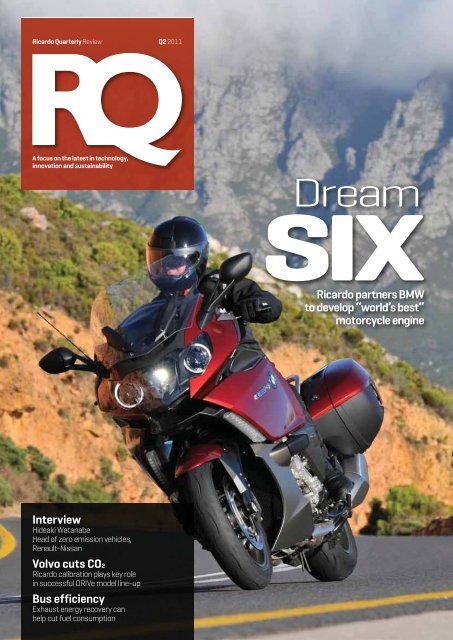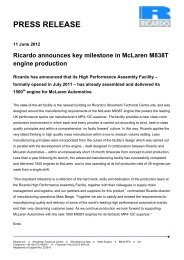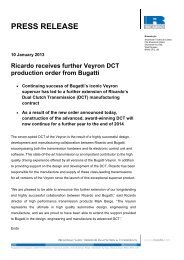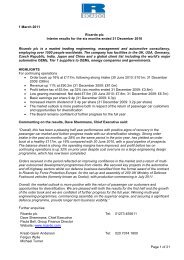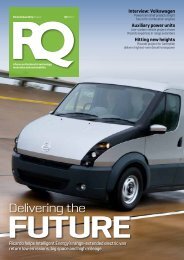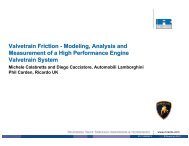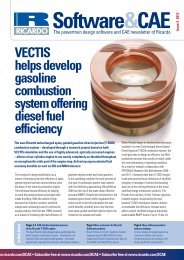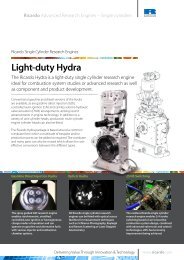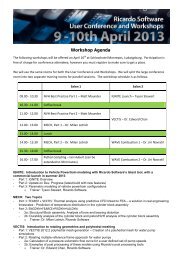Ricardo partners BMW to develop âworld's bestâ motorcycle engine ...
Ricardo partners BMW to develop âworld's bestâ motorcycle engine ...
Ricardo partners BMW to develop âworld's bestâ motorcycle engine ...
Create successful ePaper yourself
Turn your PDF publications into a flip-book with our unique Google optimized e-Paper software.
<strong>Ricardo</strong> Feature heading Quarterly Review Q2 2011<br />
A focus on the latest in technology,<br />
innovation and sustainability<br />
Dream<br />
SIX<br />
<strong>Ricardo</strong> <strong>partners</strong> <strong>BMW</strong><br />
<strong>to</strong> <strong>develop</strong> “world’s best”<br />
mo<strong>to</strong>rcycle <strong>engine</strong><br />
Interview<br />
Hideaki Watanabe<br />
Head of zero emission vehicles,<br />
Renault-Nissan<br />
Volvo cuts CO2<br />
<strong>Ricardo</strong> calibration plays key role<br />
in successful DRIVe model line-up<br />
Bus efficiency<br />
Exhaust energy recovery can<br />
help cut fuel consumption
<strong>BMW</strong> 1600GT/GTL<br />
six<br />
Dream<br />
MOTORCYCLES & PERSONAL TRANSPORTATION<br />
Soon after winning a contract <strong>to</strong> upgrade the <strong>BMW</strong> four-cylinder mo<strong>to</strong>rcycle<br />
<strong>engine</strong> family in 2006, <strong>Ricardo</strong> was awarded an even more prestigious task – <strong>to</strong><br />
design a new, six-cylinder <strong>engine</strong>, from scratch, <strong>to</strong> power a new, best-in-theworld<br />
sports <strong>to</strong>urer. Jesse Crosse takes up the s<strong>to</strong>ry.<br />
Designing a new sports <strong>to</strong>uring<br />
mo<strong>to</strong>rcycle will always be a challenge,<br />
but designing a radically new one <strong>to</strong> be<br />
the very best in the world is a <strong>to</strong>ugher<br />
one than most. So for its new <strong>to</strong>p of<br />
the range 1600GT and 1600GTL bikes,<br />
<strong>BMW</strong> Mo<strong>to</strong>rrad drew inspiration from<br />
the heritage of its au<strong>to</strong>motive sister<br />
by choosing a straight-six <strong>engine</strong><br />
configuration that would deliver a level<br />
of refinement unmatched by any fourcylinder<br />
mo<strong>to</strong>rcycle <strong>engine</strong> in existence.<br />
Although a number of six-cylinder<br />
mo<strong>to</strong>rcycles have appeared over the<br />
years, they are rare – and the length and<br />
bulk of these <strong>engine</strong>s presents major<br />
challenges when it comes <strong>to</strong> packaging<br />
and handling. The new <strong>BMW</strong> would<br />
be no American-style straight-road<br />
cruiser: instead, it would need <strong>to</strong> offer<br />
world class levels of agility, handling and<br />
steering.<br />
<strong>Ricardo</strong> has enjoyed a close<br />
relationship with <strong>BMW</strong> Mo<strong>to</strong>rrad for<br />
a number of years and had already<br />
undertaken a number of smaller<br />
mo<strong>to</strong>rcycle projects for the Munichbased<br />
manufacturer. Then in 2006<br />
<strong>Ricardo</strong> was invited <strong>to</strong> re-<strong>engine</strong>er<br />
the four-cylinder K1200 <strong>engine</strong><br />
<strong>to</strong> produce a new family of K1300<br />
mo<strong>to</strong>rcycles for 2009 (see RQ Q2 2009).<br />
It was a substantial task, quickly and<br />
successfully undertaken by <strong>Ricardo</strong><br />
drawing on expertise at its sites across<br />
Europe in the UK, the Czech Republic<br />
and Schwäbisch Gmünd in Southern<br />
Germany.<br />
Yet even while the K1300<br />
<strong>develop</strong>ment was still underway, <strong>Ricardo</strong><br />
10
<strong>BMW</strong> 1600GT/GTL<br />
was awarded a <strong>to</strong>p-secret project <strong>to</strong><br />
support the design of a new, compact,<br />
lightweight six that would rewrite<br />
the rulebook of mo<strong>to</strong>rcycle <strong>engine</strong><br />
design. Remarkably, perhaps, <strong>Ricardo</strong><br />
was awarded the six-cylinder project<br />
almost in parallel with the four-cylinder.<br />
The two programmes ran in tandem,<br />
the six cylinder work benefiting from<br />
experience gained during the early<br />
design activities with <strong>BMW</strong> on the<br />
K1300 programme. Again, the project<br />
was directed from <strong>Ricardo</strong>’s division<br />
in Schwäbisch Gmünd, where the <strong>to</strong>p<br />
end of the <strong>engine</strong> was also designed.<br />
The bot<strong>to</strong>m end was designed at<br />
the Shoreham and Prague Technical<br />
Centres, with the gearbox designed<br />
and produced at the Midlands Technical<br />
Centre in Leaming<strong>to</strong>n, England. The<br />
procurement, build,<br />
<strong>develop</strong>ment and<br />
validation testing of the <strong>engine</strong><br />
were all carried out in Schwäbisch<br />
Gmünd, <strong>to</strong>gether with <strong>BMW</strong>. The<br />
later stages of the programme<br />
such as refinement of the <strong>engine</strong><br />
in the vehicle, smooth driveability,<br />
<strong>engine</strong> management application<br />
and industrialisation were <strong>BMW</strong>’s<br />
responsibility.<br />
Key targets were smoothness,<br />
impressive fuel economy and NVH<br />
characteristics, driveline refinement<br />
and shift quality; substantial <strong>engine</strong><br />
<strong>to</strong>rque (175 Nm) would take precedence<br />
over outright power. While six cylinders<br />
would be ideal for delivering the<br />
exceptional levels of refinement<br />
for which <strong>BMW</strong> is famous, the bikes<br />
would still need <strong>to</strong> corner well: with<br />
the six-cylinder <strong>engine</strong> arranged<br />
transversely in the frame, guaranteeing<br />
sufficient ground clearance would pose<br />
a challenge from the outset. Earlier<br />
in-line six-cylinder bikes had been <strong>to</strong>o<br />
wide, and manufacturers eventually<br />
confined themselves <strong>to</strong> a maximum<br />
of four cylinders for that reason. The<br />
target weight for the power train was<br />
also challenging, important not just<br />
for the agility and handling, but for fuel<br />
consumption <strong>to</strong>o.<br />
Packaged <strong>to</strong> minimize width<br />
The vehicle package layout allowed for<br />
six cylinders inclined forward, much like<br />
the four-cylinder K1300 <strong>engine</strong>, the basic<br />
vehicle layout being similar <strong>to</strong> the proven<br />
and very successful K1300GT bike.<br />
11
<strong>BMW</strong> 1600GT/GTL<br />
“<strong>Ricardo</strong> was<br />
selected as a<br />
partner primarily<br />
on account of<br />
the fact that the<br />
<strong>develop</strong>ment philosophies of<br />
<strong>BMW</strong> Mo<strong>to</strong>rrad and <strong>Ricardo</strong> are<br />
very similar. This was confirmed<br />
as the project progressed”<br />
Heinz Hege,<br />
project leader,<br />
powertrain,<br />
<strong>BMW</strong> Mo<strong>to</strong>rad<br />
The <strong>Ricardo</strong>designed<br />
six-speed<br />
transmission uses<br />
helical gears for<br />
superior NVH and<br />
shift quality<br />
The project began with detailed<br />
concept layout drawings from <strong>BMW</strong>,<br />
outlining how the <strong>engine</strong> should look<br />
and defining the basic package for the<br />
<strong>engine</strong>. “We worked very closely with<br />
the <strong>BMW</strong> team <strong>to</strong> achieve the look<br />
they wanted as well as the technical<br />
targets,” explains the <strong>Ricardo</strong> project<br />
chief <strong>engine</strong>er, Paul Etheridge. The fourcylinder<br />
is already a proven package<br />
from the point of view of ergonomics,<br />
weight distribution and power<br />
delivery, so it made sense <strong>to</strong> maintain<br />
those essential characteristics. But<br />
surprisingly, the 160 hp six-cylinder<br />
‘drive-by-wire’ <strong>engine</strong> is very pure in<br />
its design and, although it has four<br />
valves per cylinder, the cam timing is<br />
fixed and the cylinders are fed through<br />
a single throttle body with multipoint<br />
injection and long ram pipes. This helps<br />
<strong>to</strong> promote <strong>to</strong>rque and flexibility. This<br />
is an ideal configuration for a <strong>to</strong>uring<br />
bike, which must deliver fuss-free and<br />
accessible performance <strong>to</strong> the rider for<br />
hours on end.<br />
The <strong>engine</strong> drives through a six-speed<br />
gearbox with the usual dog engagement<br />
in preference <strong>to</strong> the synchromesh<br />
system found in cars. The gearbox is<br />
designed as a separate module which<br />
can be removed without the need <strong>to</strong><br />
split the <strong>engine</strong> crankcase. Rather<br />
than being straight-cut in common<br />
with most other mo<strong>to</strong>rcycles, the<br />
gears are helical like those in a car<br />
transmission. This design is quieter<br />
and leads <strong>to</strong> a lighter gear shift, both<br />
significant benefits for a <strong>to</strong>uring bike.<br />
To achieve the ultimate in refinement<br />
and shift quality there are three<br />
compliant elements in the driveline, two<br />
of which are a <strong>to</strong>rsional spring pack in<br />
the clutch and a <strong>to</strong>rsional damper in the<br />
driveshaft. There is a third, <strong>to</strong>o, inside<br />
the gearbox and fitted <strong>to</strong> a third shaft<br />
– which means the gearbox is equipped<br />
with a <strong>to</strong>tal of three shafts rather than<br />
the usual two. In the later stages of the<br />
12
<strong>BMW</strong> 1600GT/GTL<br />
programme the gearbox was redesigned<br />
by the production supplier <strong>to</strong> suit their<br />
specific manufacturing requirements.<br />
The overall package is very compact,<br />
especially across the width of the bike.<br />
Normally, the crankshaft length of a<br />
six-cylinder <strong>engine</strong> would mean having<br />
a <strong>to</strong>rsional vibration damper (TVD)<br />
fitted within the shaft or at its end. But<br />
<strong>Ricardo</strong> was given precise specifications<br />
based on the maximum lean angle of<br />
the bike, which placed a restriction<br />
on the length of the crankshaft and<br />
also the size of any counterweights<br />
incorporated in the webs of the crank.<br />
One way of minimizing width is <strong>to</strong> keep<br />
the bores small and close <strong>to</strong>gether, and<br />
in this case they are separated from one<br />
another by only 5 mm.<br />
Repositioned ancillaries<br />
Ancillaries like the alterna<strong>to</strong>r and starter<br />
drives that would normally be mounted<br />
on the end of the crank are mounted<br />
behind the <strong>engine</strong> in a cassette assembly.<br />
This is easily removed for servicing and<br />
driven by a separate drive from the back<br />
of the clutch. Yet it was clear that some<br />
advanced crankshaft design would be<br />
necessary <strong>to</strong> meet the required targets.<br />
Six-cylinder car crankshafts always<br />
have TVDs fitted and the longer the<br />
crankshaft, the more <strong>to</strong>rsional vibration<br />
it is likely <strong>to</strong> suffer. Resonances that can<br />
be noisy or damaging <strong>to</strong> the crankshaft<br />
always appear somewhere in the speed<br />
range, so the team knew they were faced<br />
with an unusually difficult task. To keep<br />
the natural <strong>to</strong>rsional frequency of the<br />
crankshaft high and out of the usable<br />
speed range, a good approach is <strong>to</strong><br />
minimize the size of the counterweights.<br />
Larger counterweights would only lower<br />
the natural frequencies and amplify<br />
<strong>to</strong>rsional vibration, but counterweights<br />
do two important jobs – they reduce<br />
the loading on the individual main<br />
bearings and also prevent bending of the<br />
crankshaft. So there is a trade-off and<br />
a compromise <strong>to</strong> be found – something<br />
that was achieved with extensive analysis<br />
using <strong>Ricardo</strong>’s ENGDYN software.<br />
The crankshaft was originally<br />
designed <strong>to</strong> be manufactured using the<br />
‘forged flat and twisted’ method, but<br />
<strong>Ricardo</strong> liaised with suppliers <strong>to</strong> adopt<br />
the ‘forged in position’ method. This,<br />
while more complex, gives a betterquality<br />
end result.<br />
Efficient combustion<br />
The valve train is a four valve per cylinder,<br />
double overhead cam system. Designed<br />
for simplicity and robustness, it is a very<br />
straightforward ‘direct attack’ layout<br />
with chain-driven camshafts and the<br />
cam lobes acting on graded bucket<br />
tappets. The cams are made of built-up,<br />
hollow steel, designed in this way <strong>to</strong> save<br />
weight, a unique feature on a mo<strong>to</strong>rcycle<br />
<strong>engine</strong>.<br />
The camshaft profiles are not an<br />
Co-operation with<br />
<strong>Ricardo</strong>: the <strong>BMW</strong> view<br />
“<br />
<strong>Ricardo</strong> was selected as a partner<br />
primarily on account of the fact that the<br />
<strong>develop</strong>ment philosophies of <strong>BMW</strong> Mo<strong>to</strong>rrad and<br />
<strong>Ricardo</strong> are very similar. This was confirmed as the<br />
project progressed.<br />
<strong>BMW</strong> provided detailed information<br />
(specifications for suppliers / drawings / 3D models)<br />
in which the <strong>engine</strong> package and the installed<br />
position in the mo<strong>to</strong>rcycle were described. <strong>Ricardo</strong><br />
bore sole responsibility for designing and modelling<br />
the basic <strong>engine</strong> including gearbox and clutch, but<br />
the work was carried out in close co-operation<br />
with <strong>BMW</strong>. Some important Tier 2 suppliers were<br />
integrated in<strong>to</strong> <strong>develop</strong>ment; production-related<br />
boundary conditions were agreed with these parties.<br />
<strong>Ricardo</strong> also bore responsibility for procuring and<br />
building the pro<strong>to</strong>type B0 <strong>engine</strong>s (10 parts sets)<br />
and the B1 <strong>engine</strong>s (20 parts sets). Functionality<br />
and durability were tested on the <strong>engine</strong> test beds<br />
in Schwäbisch Gmünd and, partly with assistance<br />
from <strong>BMW</strong>, the basic Motronic application and power<br />
<strong>develop</strong>ment were progressed.<br />
Development of the intake and exhaust systems<br />
and the vehicle cooling were <strong>BMW</strong> responsibilities,<br />
with optimization being undertaken in close contact<br />
xxxxxxx<br />
with <strong>Ricardo</strong>’s modelling results. B1 <strong>engine</strong>s were<br />
installed in vehicles (10 off) at <strong>BMW</strong>, and <strong>BMW</strong><br />
used these vehicles <strong>to</strong> conduct functional trials<br />
and endurance tests in the course of which areas<br />
for further <strong>develop</strong>ment emerged in the oil supply,<br />
<strong>engine</strong> acoustics, and in the durability of the gearbox.<br />
Pre-release of the component drawings for the<br />
basic <strong>engine</strong> (not including gearbox and clutch - <strong>BMW</strong><br />
continued modifying these components <strong>to</strong>gether<br />
with the series suppliers) marked the conclusion of<br />
<strong>Ricardo</strong>’s involvement in <strong>develop</strong>ment. The task of<br />
incorporating minor adjustments in<strong>to</strong> the drawings<br />
up <strong>to</strong> production release was entrusted <strong>to</strong> a <strong>Ricardo</strong><br />
designer. Further <strong>develop</strong>ment and preparation for<br />
industrial production from pre-release onward was<br />
continued by <strong>BMW</strong>, with the major issues being the<br />
optimization of <strong>engine</strong> operation, <strong>engine</strong> acoustics<br />
and power <strong>develop</strong>ment.<br />
Co-operation with <strong>Ricardo</strong> was very positive overall.<br />
It was characterised by mutual understanding and<br />
trust. The durability of the basic <strong>engine</strong> components<br />
designed by <strong>Ricardo</strong> was always unproblematic;<br />
component rig tests and endurance runs received<br />
positive confirmation with series-production parts.<br />
Even closer co-operation would be desirable for future<br />
projects, with a higher degree of interaction between<br />
designers / test <strong>engine</strong>ers. Similarly, responsibility<br />
for <strong>develop</strong>ment activities up <strong>to</strong> series-ready<br />
status (production release) should be shifted more<br />
effectively <strong>to</strong> <strong>Ricardo</strong> for future projects.<br />
Heinz Hege<br />
Project leader, powertrain,<br />
<strong>BMW</strong> Mo<strong>to</strong>rrad<br />
“<br />
13
<strong>BMW</strong> 1600GT/GTL<br />
Technical data:<br />
<strong>BMW</strong> 1600GT/GTL<br />
Engine<br />
Type<br />
Oil/water cooled 4-stroke in-line<br />
6-cylinder <strong>engine</strong>, two overhead<br />
camshafts, four valves per<br />
cylinder<br />
72mm x 67.5mm<br />
1,649cc<br />
160 hp at 7,750 rev/min<br />
175 Nm at 5,250 rev/min<br />
Bore x stroke<br />
Capacity<br />
Rated output<br />
Max. <strong>to</strong>rque<br />
Compression ratio 12.2:1<br />
Mixture control<br />
/<strong>engine</strong> management Electronic intake pipe injection,<br />
digital <strong>engine</strong> management<br />
(BMS-X)<br />
Emission control<br />
Closed-loop 3-way catalytic<br />
converter, emission standard<br />
EU-3<br />
Performance / fuel consumption<br />
Maximum speed Over 200 km/h<br />
Fuel consumption<br />
per 100 km at<br />
constant 90 km/h 4.5L (GT) 4.6L (GTL)<br />
Fuel consumption per<br />
100 km at constant<br />
120 km/h 5.7L (GT) 5.9L (GTL)<br />
Fuel type<br />
Unleaded super, octane number<br />
95 (RON)<br />
Electrical System<br />
Alterna<strong>to</strong>r<br />
Battery<br />
Power transmission<br />
Clutch<br />
Gearbox<br />
Drive<br />
Three-phase alterna<strong>to</strong>r 580W<br />
12V/19Ah, maintenance free<br />
Multiple-disc clutch in oil bath<br />
6-speed, helical gearbox<br />
Cardan Shaft<br />
‘aggressive’ design, says Etheridge, but<br />
have been designed <strong>to</strong> be as efficient and<br />
durable as possible – as befits a <strong>to</strong>uring<br />
bike <strong>engine</strong>. Valves sit in a well-proven<br />
pent-roof design of combustion chamber<br />
and the inlet ports are not symmetrical,<br />
but narrow <strong>to</strong>wards the rear of the <strong>engine</strong><br />
<strong>to</strong> fit the external dimensions of the<br />
<strong>engine</strong> and vehicle package.<br />
Cylinders are Nikasil-plated with a<br />
slightly over-square bore and stroke<br />
of 72 mm x 67.5 mm. The <strong>engine</strong> was<br />
designed with a dry sump in order <strong>to</strong><br />
keep the centre of gravity as low as<br />
possible but, unlike the four-cylinder<br />
K1300 <strong>engine</strong> which has a plastic oil<br />
tank behind the <strong>engine</strong>, the new six has<br />
an integral oil tank inside the crankcase.<br />
This gave <strong>BMW</strong> more opportunities with<br />
the mo<strong>to</strong>rcycle package.<br />
Efficiency was the watchword<br />
throughout the <strong>develop</strong>ment<br />
programme, with the choice of bore and<br />
stroke yielding an effective surface-<strong>to</strong>volume<br />
ratio for optimum combustion<br />
characteristics. A six-cylinder <strong>engine</strong><br />
is inherently smooth and, unlike a fourcylinder,<br />
requires no balancer shafts <strong>to</strong><br />
achieve high levels of refinement. This<br />
reduces frictional losses and gives fuel<br />
economy benefits.<br />
Substantial task<br />
While the four-cylinder programme<br />
was an upgrade, the clean-sheet<br />
design of the six was clearly a much<br />
more substantial task. <strong>Ricardo</strong> had full<br />
responsibility not just for the design of<br />
the six, but also the <strong>develop</strong>ment during<br />
two stages of pro<strong>to</strong>typing. The task<br />
was <strong>to</strong> deliver pro<strong>to</strong>type <strong>engine</strong>s in two<br />
separate phases; also included was all<br />
the component procurement. During<br />
the programme <strong>Ricardo</strong> operated as a<br />
department of <strong>BMW</strong>. Indeed, <strong>Ricardo</strong> is<br />
the only <strong>BMW</strong> supplier with full access<br />
<strong>to</strong> its product <strong>develop</strong>ment database,<br />
using a satellite workstation.<br />
With pro<strong>to</strong>types complete, says<br />
Etheridge, “we were responsible<br />
for the base <strong>engine</strong> <strong>develop</strong>ment,<br />
finally supplying validated pro<strong>to</strong>type<br />
The new 6-cylinder<br />
<strong>engine</strong> goes in<strong>to</strong><br />
production at <strong>BMW</strong><br />
14
<strong>BMW</strong> 1600GT/GTL<br />
powertrains <strong>to</strong> <strong>BMW</strong> for vehicle<br />
<strong>develop</strong>ment.”<br />
Powertrain testing included<br />
performance <strong>develop</strong>ment, combustion<br />
<strong>develop</strong>ment and basic mechanical<br />
<strong>develop</strong>ment with <strong>engine</strong> tests and<br />
component rig tests for the pro<strong>to</strong>types.<br />
At this stage <strong>Ricardo</strong>’s work was<br />
essentially complete, although its remit<br />
included maintaining a presence for<br />
any detail design changes that were<br />
needed, as well as the validation of<br />
subsequent production-intent units.<br />
First manufacturing integration was<br />
incorporated at the design stage, and<br />
<strong>Ricardo</strong> was also on hand <strong>to</strong> update<br />
manufacturing drawings as required<br />
during industrialization.<br />
Rave reviews<br />
The K1600 <strong>engine</strong> has already been<br />
a hit with the press. The UK Daily<br />
Telegraph said of the 1600GT, “just a<br />
silky delivery of power unlike any fourcylinder<br />
rival, with immense strength,<br />
<strong>to</strong>o. It’s enormously satisfying,<br />
especially as the bike powers forward<br />
so rapidly when you spin the mo<strong>to</strong>r<br />
close <strong>to</strong> its 8,500 rev/min red line.”<br />
Ride magazine was similarly<br />
impressed, saying, “It is an amazingly<br />
smooth <strong>engine</strong>, untroubled by<br />
intrusive vibes, rattles or shakes.”<br />
Mo<strong>to</strong>rcycle News simply declared it<br />
“one of the most in<strong>to</strong>xicating <strong>engine</strong>s in<br />
mo<strong>to</strong>rcycling”.<br />
Fitting tributes, perhaps, for what<br />
has <strong>to</strong> be one of the most refined and<br />
neatly packaged mo<strong>to</strong>rcycle <strong>engine</strong>s in<br />
the world.<br />
As with the K1300 four cylinder<br />
<strong>engine</strong> project, the new K1600 <strong>engine</strong><br />
and transmission is another very high<br />
profile testimony <strong>to</strong> one of the most<br />
effective <strong>engine</strong>ering collaborations in<br />
the global mo<strong>to</strong>rcycle industry. Bearing<br />
all the hallmarks of a truly great bike<br />
<strong>engine</strong>, the six-cylinder K1600 takes<br />
premium mo<strong>to</strong>rcycling in<strong>to</strong> a new and<br />
exciting dimension in which <strong>engine</strong>ering<br />
sophistication combines with genuine<br />
rider appeal <strong>to</strong> set new standards in the<br />
elite segment.<br />
“We worked very<br />
closely with the<br />
<strong>BMW</strong> team <strong>to</strong><br />
achieve the look<br />
they wanted as well<br />
as the technical targets ”<br />
Paul Etheridge,<br />
Project chief <strong>engine</strong>er,<br />
<strong>Ricardo</strong>Engineer<br />
<strong>Ricardo</strong>’s Mo<strong>to</strong>rcycle<br />
Centre of Excellence<br />
Uwe Moser was project direc<strong>to</strong>r for both the K1300<br />
and K1600 <strong>engine</strong> programmes at <strong>Ricardo</strong> and,<br />
<strong>to</strong>gether with the support of Paul Etheridge, he<br />
founded the Mo<strong>to</strong>rcycle Centre of Excellence in<br />
Schwäbisch Gmünd. His focus is on continuing <strong>to</strong><br />
xxxxxxx build this group in<strong>to</strong> a world-leading <strong>engine</strong>ering<br />
partner for mo<strong>to</strong>rcycle OEMs: “From the first of<br />
June we have appointed additional Chief Engineers<br />
and <strong>Ricardo</strong> is very serious about growing in this<br />
market.”<br />
The Mo<strong>to</strong>rcycle Centre of Excellence has grown<br />
steadily over the last few years and while based<br />
in Germany, it is a global focus for activity in this<br />
market for <strong>Ricardo</strong>. “Worldwide, the emphasis<br />
continues <strong>to</strong> be on fuel consumption and CO2,”<br />
Moser continues. “In Asia, cus<strong>to</strong>mers are focused<br />
on cost of ownership for smaller bikes, and we see<br />
a growing demand in this market for an improved<br />
quality of small bikes and mopeds.”<br />
The global market is evolving in other ways <strong>to</strong>o.<br />
“The market is moving from two directions; in Asia<br />
from the simple commuter bikes <strong>to</strong> a higher level<br />
and, for the established European and Japanese<br />
brands, a trend for offering smaller bikes as an entry<br />
level in the <strong>develop</strong>ed markets, and a high end bike<br />
for <strong>develop</strong>ing markets.” With a global convergence<br />
<strong>to</strong>wards mo<strong>to</strong>rcycles of 200 cc <strong>to</strong> 250 cc growing,<br />
it seems a dramatic shift in the world market for<br />
mo<strong>to</strong>rcycles is about <strong>to</strong> begin.<br />
The <strong>develop</strong>ment of the Mo<strong>to</strong>rcycle Centre of<br />
Excellence has proven <strong>to</strong> be a <strong>Ricardo</strong> success<br />
s<strong>to</strong>ry as demonstrated not least by the two recent<br />
and very high profile <strong>BMW</strong> programmes, which<br />
have been so well received in the market. The team<br />
continues <strong>to</strong> work with its cus<strong>to</strong>mers in Germany<br />
and around the world, with investment in new,<br />
mo<strong>to</strong>rcycle-specific personnel and new facilities <strong>to</strong><br />
support the expansion of this important business<br />
for <strong>Ricardo</strong>.<br />
15


